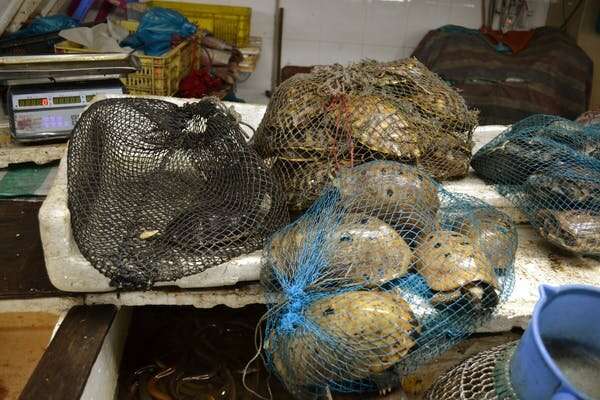
Since the beginning of the coronavirus pandemic, eating the meat of wild animals has been getting a bad press.
Last month, more than 300 conservation groups signed an open letter asking the World Health Organization (WHO) to take measures to prevent new diseases emerging from wild animals. This included banning the sale of wild animal meat, also known as bushmeat. The request stemmed from evidence that SARS-CoV-2 likely originated in a wild animal, probably a species of bat, before jumping to an intermediate host, possibly a pangolin, and then infecting a human.
Although exactly where the first person picked up the virus is hotly contested, the media and researchers have focused on China’s wet markets, particularly those selling wild animals and their meat. At these markets, finding civet cats, turtles, bats and pangolins kept alive in small cages, often in close proximity, is not uncommon. In such conditions, wild animals can incubate diseases that later spill over into humans.
In response, the Chinese government has issued a temporary ban on farming, selling and eating wild animals, and many—including the United Nations biodiversity chief, Elizabeth Maruma Mrema – have urged Beijing to make this ban permanent.
But a truly successful ban on the sale of bushmeat in China may not even be possible. And if upheld, it could hinder rather than help the prevention of further pandemics. Here’s why.
Outlawing bushmeat is trickier than it looks
Previously adopted behavioural change campaigns, policy lobbying and law enforcement have failed to reduce the consumption of wild animals over the past 10 years. And this is not only in China, but in West Africa and South America too.
Bushmeat is popular. Consumers believe that eating wild animals is normal, respectful of traditions, medicinal and even healthy. Part of the problem in China specifically is that wild animal products form an integral part of traditional Chinese medicine and in supplementing diets.
For some, bushmeat is consumed daily as the only accessible and affordable protein source. For others, it’s a luxury product, enjoyed to celebrate special occasions or to boost health. In fact, the attraction of wet markets isn’t so different from that of farmers’ markets in western countries.
Because of bushmeat’s cultural value, taking away the choice to consume it permanently would probably be resisted. It would also likely encourage unregulated underground markets.
This happened in the West African Ebola outbreak in 2013-16, where underground markets for bushmeat began to appear after it was banned. And this is being seen during the temporary ban in China too, as some sellers have started dealing online instead. In February alone, 140,000 webpages and 17,000 online trader accounts relating to the sale of bushmeat or wild animal parts for medicinal use were removed, deleted or blocked by China’s State Council.
The emergence of online markets increases the risk of further disease outbreaks due to the increased and untraced movement of bushmeat across the country. The movement of wildlife meat is known to spread pathogens to new areas. More needs to be done to stop this.
How to reduce the danger of bushmeat
Before any working long-term ban can be introduced, enforced and followed in China, there’s a lot that needs to happen.
The Chinese government and the WHO will need to develop policies and guidelines on the risks involved with collecting, handling and consuming bushmeat. They’ll also need to restrict the number of species allowed to be sold and consumed—and stick to this. The Chinese government banned the consumption of civet cats following the SARS outbreak, for instance, but later overturned the ban.
Instead of a ban on all wildlife, the government could consider increasing regulations around the trade of certain species that pose the highest risk. It could also, as some have suggested, provide seeds for agriculture and fish for aquaculture, to lessen the reliance on bushmeat as a food source.
The government will also have to increase consumer education and food safety standards, and provide alternative livelihoods to hunters and market traders.
It will also be crucial to develop new surveillance systems that track, isolate and contain emerging infectious diseases in wild animals, before they have the opportunity to affect humans. Lessons can be learned from the PREDICT programme, run by the United States Agency for International Development, which used broad surveillance to hunt for dangerous pathogens in animals. Between 2009 and 2019, it collected over 140,000 biological samples from animals, finding over 1,000 new viruses, including a new strain of Ebola.
But most importantly, authorities will have to understand the role of bushmeat in local contexts, specifically the practices and behaviours around its collection and consumption. They will then need to design tailored interventions that can reduce communities’ reliance on wild animal products.
For example, researchers studying the socioeconomics of bushmeat during the 2013-16 Ebola epidemic found that to lessen reliance on it, we should concentrate on improving jobs and access to quality protein sources, rather than focus on the meat itself.
Source: Read Full Article
